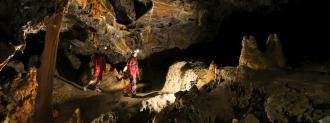Fifteen volunteers in France just spent more than a month living in a cave — without any way to tell time — as part of an isolation experiment that could inform future missions to space.
The challenge: Most of us live on a 24-hour cycle. We wake up in the morning, and go to sleep in the evening. At certain hours of the day, we eat. At others, we work.
Researchers at the Human Adaptation Institute wanted to understand how people might react to an environment where that 24-hour cycle wasn’t dictating their every move.
When would they sleep? How would they know when to work? Would the experience affect their mental or physical health?
This information could be useful when planning human missions to space, the deep sea, or anywhere else where people might live for long periods without daylight.
To find answers, the institute designed an isolation experiment dubbed “Deep Time.”
Life in the cave: For 40 days and nights, 15 volunteers lived without clocks in a part of a cave that sunlight couldn’t reach. The temperature was held steady around 12 degrees Celsius (54 Fahrenheit) and the humidity was 95%.
The volunteers slept in tents and had to peddle a bike to create their own electricity. While they went into the cave with plenty of food, they had to fetch drinking water from an underground well.
Scientists outside the cave monitored the “deeptimers” throughout the isolation experiment, using sensors to keep track of their sleep patterns, body temperatures, and more.
Going with the flow: Because the volunteers had no way to tell time, they relied on their biological clocks, sleeping and eating whenever they felt like it was time to sleep or eat.
That wasn’t so hard, but figuring out how to work together to complete tasks without being able to say something like, “Meet me at the well at noon” was a challenge.
You never knew when you woke up, who’s waiting for you or what you need to do.
Marina Lançon
“All those tasks need to be several people, like three or four people, so that was difficult because you never knew when you woke up, who’s waiting for you or what you need to do,” volunteer Marina Lançon told CBC.
Sense of time: The day before the project ended, the scientists entered the cave to let the volunteers know it was time to start packing up — and that came as a surprise to quite a few of them.
Project director Christian Clot told the Associated Press that — based on the number of times they’d gone to sleep — he and most of the other volunteers thought they were only about 75% of the way through the isolation experiment.
“In our heads, we had walked into the cave 30 days ago,” he said.
The cold water: Outside researchers have pointed out that the lack of a control group is a major limitation of the study.
Without that, the researchers won’t be able to know for sure that any changes in their volunteers were specifically due to the circumstances of the isolation experiment.
The next steps: After the volunteers emerged from the cave, they were sent to Paris to undergo MRIs.
The Human Adaption Institute will now analyze those scans, as well as data collected before and during the experiment, in the hopes of better understanding the effect of life without time on humans.
We’d love to hear from you! If you have a comment about this article or if you have a tip for a future Freethink story, please email us at [email protected].






